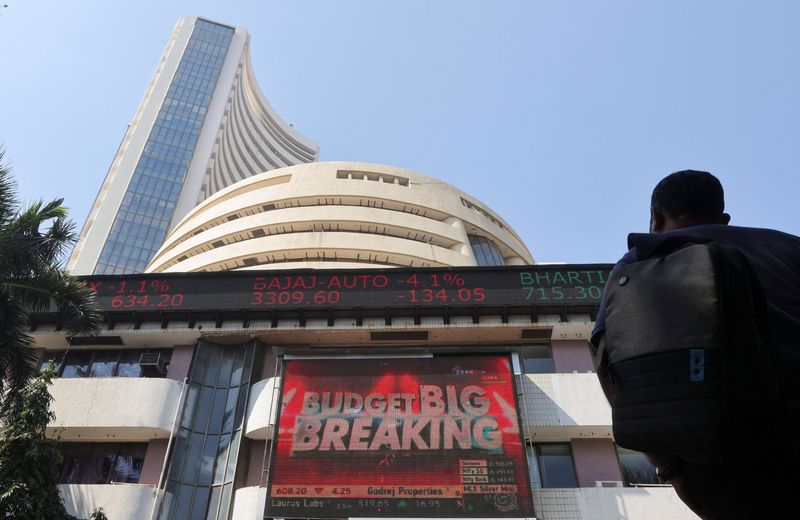By Patturaja Murugaboopathy and Gaurav Dogra
(Reuters) - Poorer 'emerging market' countries are facing the headwind of rising global interest rates this year, which in the past has prompted international investors and their capital to up anchor and sail out.
The issue is that when big developed economies like the United States jack up rates, the returns on investments like government and corporate bonds and higher interest rates offered by developing countries no longer look quite so worth the extra risk.
And financial markets now expect U.S. interest rates - which tend to drive EM borrowing costs - to go up 5 times this year and some Wall Street analysts are even predicting seven.
The last time that happened within such a short window was August 2005 to June 2006. The 10-year Treasury yield is now at 1.85% from just over 1.5% at the start of the year, which has pushed up EM rates. The average cost for an emerging market government to borrow in its own currency is now almost 6%.
(Graphic: EM sovereign bond yields, https://fingfx.thomsonreuters.com/gfx/mkt/zjvqkawwlvx/Pasted%20image%201643738218207.png)
The International Monetary Fund has made a point of warning developing economies to prepare for potential bouts of turbulence if U.S. rates go up rapidly and/or if the coronavirus pandemic worsens again.
It also says that those with strong inflation pressures or weak institutions should be ready to let their currencies drop and raise their own interest rates.
Brazil's real, Colombia's peso and, in eastern Europe the Czech crown and Hungarian forint, have all risen this year as their central banks have raised interest rates.
(Graphic: Performance of emerging countries' currencies this year, https://graphics.reuters.com/EMERGING-ECONOMIES/EMERGING-ECONOMIES/klpykmqdapg/chart.png)
These charts show some of the other metrics which traditionally make a developing country vulnerable to rising global interest rates.
1/ DEFICIT NUMBER 1
Colombia, Chile and Egypt have the biggest current account deficits as percentage of their gross domestic product (GDP), according to data from Oxford Economics, which makes them more likely to borrow the money to pay for their imports.
(Graphic: Emerging markets' current account balance ( % of GDP ), https://graphics.reuters.com/EMERGING-ECONOMIES/EMERGING-ECONOMIES/lgpdwxoemvo/chart.png)
2/ DEFICIT NUMBER 2
Colombia, South Africa and Thailand have the biggest budget deficits, meaning they have to borrow more to fill the gap.
(Graphic: Emerging countries' budget balance ( % of GDP ), https://graphics.reuters.com/EMERGING-ECONOMIES/EMERGING-ECONOMIES/egpbklogkvq/chart.png)
3/ ORIGINAL SINNERS
Qatar, United Arab Emirates and Hungary have higher levels of dollar and other 'hard currency' debt, making up more than 80% of their GDP. Borrowing in another country's currency is described by economists as the 'original sin' as a falling local currency can make it very expensive to pay back that debt very quickly.
(Graphic: Emerging countries' external debt ( % of GDP ), https://graphics.reuters.com/EMERGING-ECONOMIES/EMERGING-ECONOMIES/movanyqzdpa/chart.png)
4/ RESERVE JUDGEMENT
Argentina, Qatar and Egypt are among the countries with the lowest stockpiles of foreign exchange reserves which can be used to bolster domestic currencies and pay for goods, if needed.
(Graphic: Emerging economies' foreign currency reserves, https://graphics.reuters.com/EMERGING-ECONOMIES/EMERGING-ECONOMIES/klpykmnlgpg/chart.png)
5/ PAINFUL PAYMENTS
Sri Lanka spends far more than it brings in in taxes and other revenues just paying the interest on its debt, let alone the underlying amount. Ghana uses 44% of its revenues while Egypt, Pakistan and Kenya use 30%-40%.
(Graphic: Drowning in debt, https://graphics.reuters.com/EMERGING-DEBT/zjvqkanzrvx/chart.png)
6/ GET REAL
In real effective exchange rate terms (REER), the Brazilian real and Colombian peso are currently trading at a more than 20% discount to their 10-year averages, according to Bank of International Settlements data. In contrast, the Czech crown's REER is at a 10% premium.
(Graphic: Emerging markets' real effective exchange rates, https://graphics.reuters.com/EMERGING-ECONOMIES/EMERGING-ECONOMIES/gdpzynmaevw/chart.png)
REER is calculated on a trade-weighted basis against a basket of currencies and adjusted for inflation.
Economists say that higher and lower REERs are misalignments and both come with associated risks.

In the case of higher REERs, the risk could be economic overheating, excess and unhedged borrowing and excess capital inflows, analysts at DBS explain. With lower REERs the risk would include high imported inflation, loss of purchasing power, and external debt service difficulties.
(Graphic: Emerging economies' combined foreign flows into equity and debt markets, https://graphics.reuters.com/EMERGING-FLOWS/EMERGING-FLOWS/zgpomjnyxpd/chart.png)